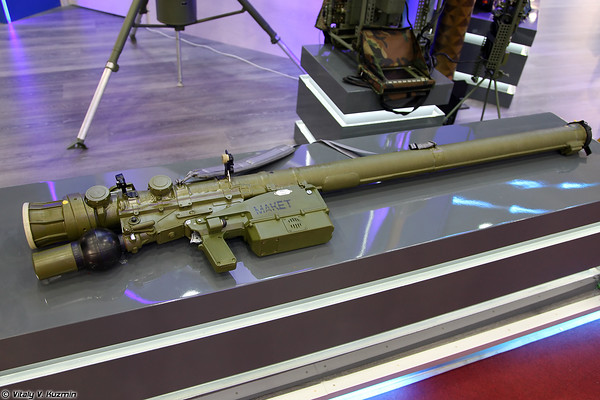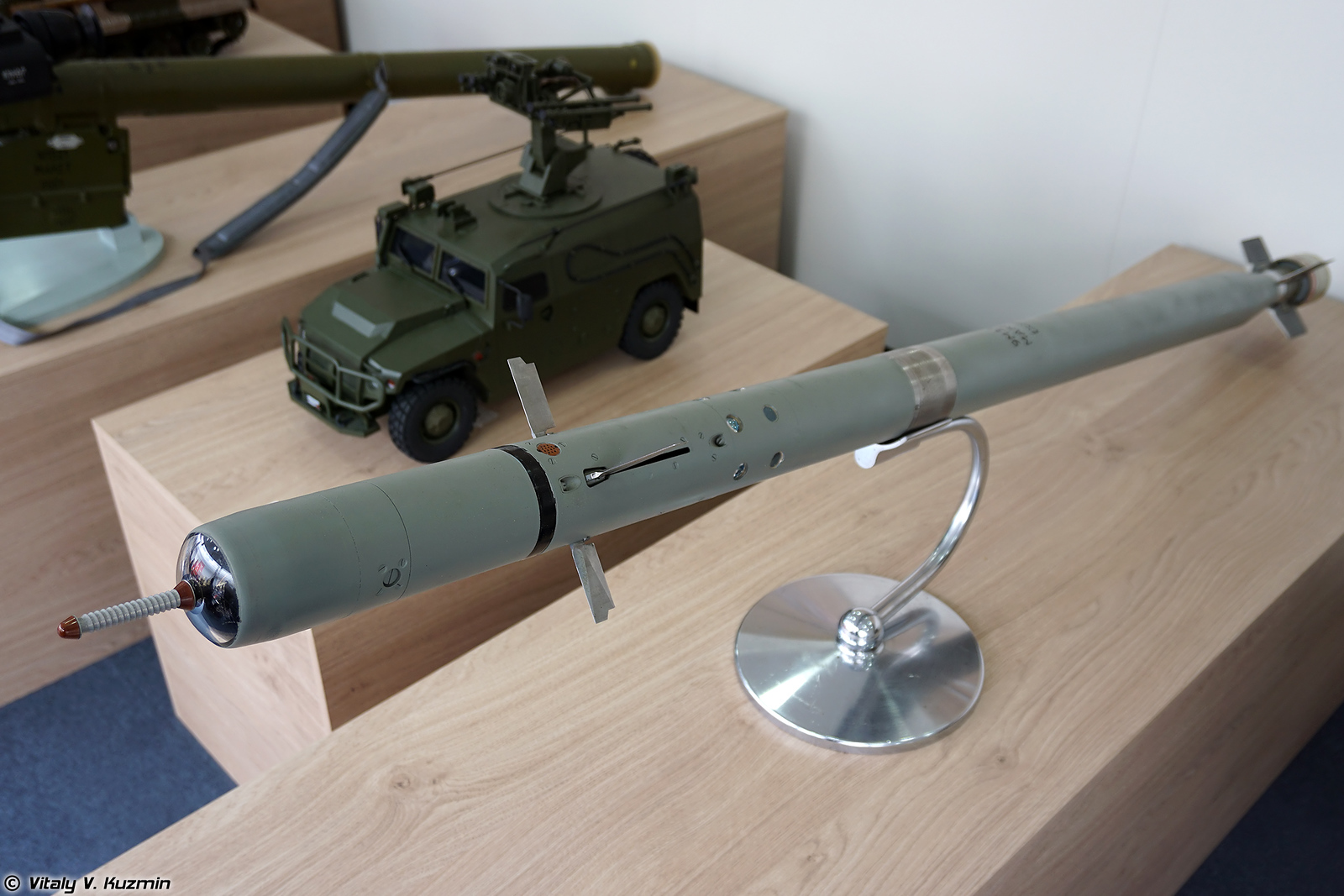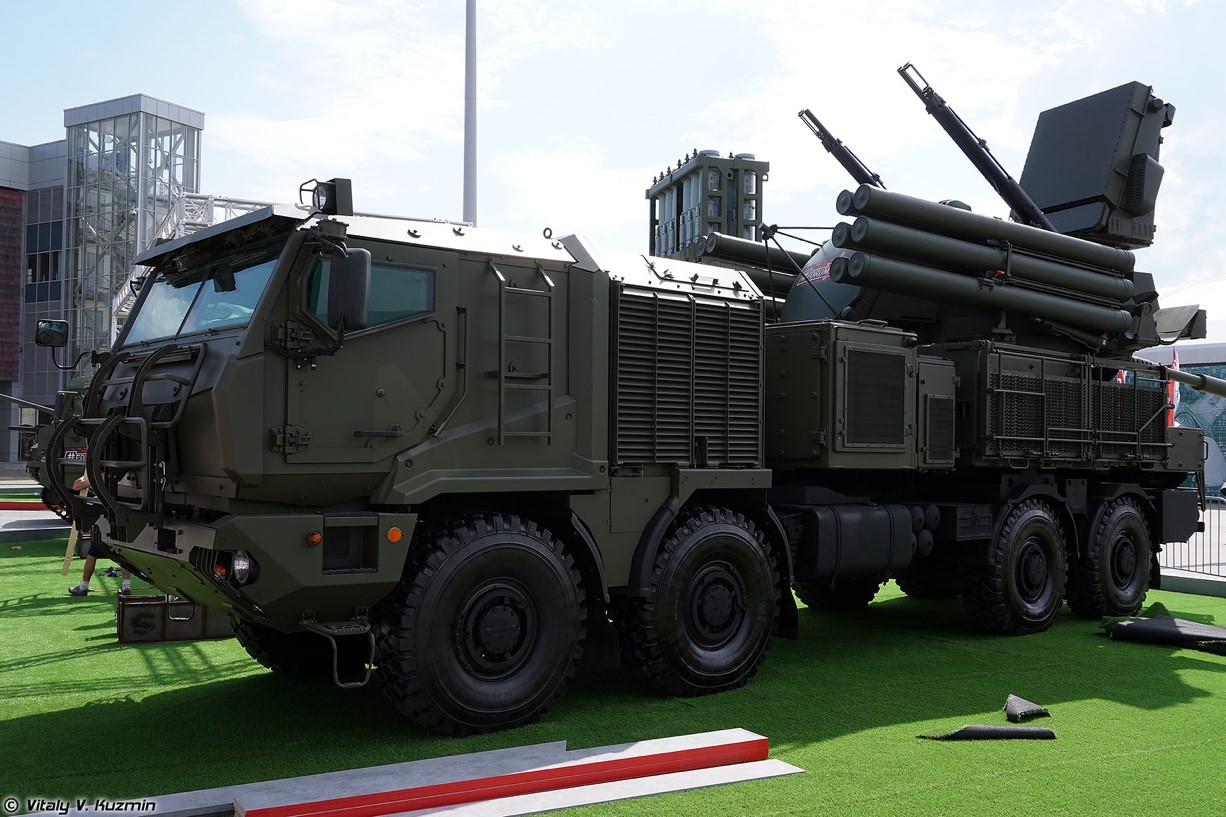
9K333 Verba MANPAD.

Missile of the 9K333 Verba MANPAD.

Pantsir-SM.
“Today, the Russian defense industry manufactures two types of anti-UAV weapons – soft-kill (electronic suppression) and hard-kill (physical destruction). According to the manufacturer, the new Pantsir-S1M is capable of operating in both modes.”
“With its [the “Verba” man-portable anti-aircraft missile system] help, they will try to create an “anti-drone dome” and intercept not only drones, but also precision guided aircraft munitions…”
The accompanying excerpted articles from Russian government news agency TASS and Russian newspaper Ivestiya discuss how existing close-range air defense systems are being modified to defeat small unmanned aerial vehicles (UAVs). According to TASS, the Russian defense industry manufactures soft-kill (electronic suppression) and hard-kill (physical destruction) anti-UAV weapons. The latest version of the Russian Aerospace Forces’ (VKS) Pantsir self-propelled anti-aircraft gun and missile system is the Pantsir-S1M, which will reportedly be capable of physically destroying UAVs while also electromagnetically interfering with their operation.
The Izvestiya article explains how the Russian Ground Forces intend to physically destroy small UAVs by way of the Verbaman-portable anti-aircraft missile system (MANPAD). According to Izvestiya, the 9K333 Verba (SA-25), a modernized variant of the 9K38 Igla (SA-18) produced by KB Mashinostroyeniya, has a more sensitive seeker, enabling it to find smaller targets, such as small UAVs. In addition, the Verba may be used as part of an integrated air defense system and can acquire data from other sensors to facilitate targeting. Although the Verba has no reported soft-kill capability as with the Pantsir-S1M, this does not mean that the Ground Forces are not pursuing soft-kill capabilities. Russian Ground Forces’ air defenses usually work closely with, and are close to, electronic warfare units that practice this skill; therefore, adding it to air defense systems is not necessary.
Source:
Vasily Kuchushev, “Панцирь-С1М и электромагнитные ружья: Как армия России будет бороться с беспилотниками (Pantsir-S1M and Electromagnetic Weapons: How the Russian Military Will Fight Drones),” TASS (Russian government news agency), 13 December 2021. https://tass.ru/armiya-i-opk/13166705
It is difficult to imagine a modern army of any state without unmanned aerial vehicles (UAVs). The tactics of their application are constantly being improved. Already today, there is a concept of using a whole swarm of drones, when one large target can be attacked by hundreds of small and cheap UAVs. The experience of modern military conflicts in Syria and Nagorno-Karabakh has shown that attacking UAVs are one of the most effective strike weapons. At the same time, small and ultra-small UAVs are actively used not only by the military, but also by terrorists…
According to the chief designer of “Pantsir” Valery Slugin, the anti-drone functions were originally part of the air defense missile system’s concept. However, at the time the system was created in the mid-90s, they were quite large. Over time, the dimensions and flight altitude of the UAV decreased, which became a serious problem for most radars. The main difficulties arose in the detection, tracking and guidance of missiles at such a target. To intercept smaller drones, the Pantsir’s radar was upgraded. The new radar can see up to 75 km, and simultaneously detect and track up to 40 targets…
Today, the Russian defense industry manufactures two types of anti-UAV weapons – soft-kill (electronic suppression) and hard-kill (physical destruction). According to the manufacturer, the new Pantsir-S1M is capable of operating in both modes. With the help of the latest electronic equipment, the Pantsir-S1M can suppress the operation of drone navigation equipment at a distance of 15-18 km.
According to Sergei Mikhailov… the modernized air defense missile system is capable of becoming the basis of tactical air defense. “On the basis of Pantsir-S1M, an effective modular air defense network can be built, capable of covering military units from small-sized and attack UAVs, high-precision weapons and, of course, military aviation – aircraft and helicopters. The complex fully complies with modern A2/AD [anti-access and area denial]. (The theory of the formation of air defense, allowing to block the enemy’s access to critical areas)”, – said Sergei Mikhailov.
For the most effective defense against unmanned aerial vehicles in Russia, an echeloned electronic countermeasures system for small-sized UAVs is being developed. The system provides reliable protection of territories and facilities from both individual drones and their groups, including swarms of drones.
Source: Anton Lavrov, Bogdan Stepovoy, Andrey Fedorov, “Укрыться под «Вербой»: над Белоруссией проверят «антидроновый купол» (Taking Cover Under ‘Verba’: An ‘Anti-Drone Dome’ Will Be Over Belarus),” Ivestiya (large circulation Russian newspaper), 21 January 2022. https://iz.ru/1280053/anton-lavrov-bogdan-stepovoi-andrei-fedorov/ukrytsia-pod-verboi-nad-belorussiei-proveriat-antidronovyi-kupol
Russian and Belarusian troops will be covered from the drones of a potential enemy. The Verba man-portable anti-aircraft missile systems (MANPADS) will be used for at the upcoming “Union Resolve-2022” large-scale maneuvers for the first time. With its help, they will try to create an “anti-drone dome” and intercept not only drones, but also precision guided aircraft munitions…
The crews of these complexes will be distributed over a large area in order to create a protective dome. In addition to intercepting the drones themselves, they will also experiment with intercepting aviation weapons – guided bombs and missiles… According to the developers, the new, much more sensitive homing head has dramatically increased the ability to deal with small objects, such as UAVs. Compared with the anti-aircraft systems of the previous generation, the capabilities of the new missile have doubled, especially at a distance of more than three kilometers. In addition, they can be linked into a single system with long-range air defense systems and receive external target designation [data]…
The Verba complex is capable of hitting aircraft, helicopters, cruise missiles and drones at altitudes from 10 to 4500 meters and at a distance of up to 6 kilometers. MANPADS received a missile with a unique three-spectral homing head, which sees targets in the ultraviolet, near and mid-infrared ranges. It is capable of distinguishing an airplane or helicopter from a thermal decoy on approach and choosing the right target…For the first time, the [command-and-control system] set includes a ‘Garmon’ portable radar, which, depending on the modification, monitors the airspace within a radius of 40-80 kilometers… two types of radars have been developed. The first one is lightweight, and can not only be transported by motor vehicles or armored vehicles, but also carried. The second is mounted, as a rule, on a tracked chassis and has higher target detection characteristics. The Barnaul-T automated tactical air defense complex integrates the Verba into the overall air defense system and can use information about air targets coming from other, more powerful radars. It allows you to create a scenario for the actions of anti-aircraft gunners, allocate targets based on capabilities, positions, combat readiness and the state of ammunition…
Image Information:
Image: 9K333 Verba MANPAD.
Source: Vitaly Kuzmin, https://photos.smugmug.com/Military/ARMY-2016-Static-part4/i-GXpqd8Q/0/a8347be1/M/Army2016-552-M.jpg
Attribution: CC BY-NC-ND 4.0
Image: Missile of the 9K333 Verba MANPAD.
Source: Vitaly Kuzmin, https://photos.smugmug.com/Military/ARMY-2019-Exhibition-pavilions/i-nXrbftn/0/ec20d1fe/X3/Army2019Pavilions-069-X3.jpg
Attribution: CC BY-NC-ND 4.0
Image: Pantsir-SM.
Source: Vitaly Kuzmin, https://www.vitalykuzmin.net/Military/ARMY-2019-Static-part-3/i-GMsTdcm#
Attribution: CC BY-NC-ND 4.0
